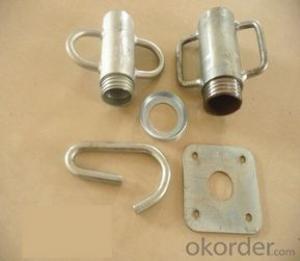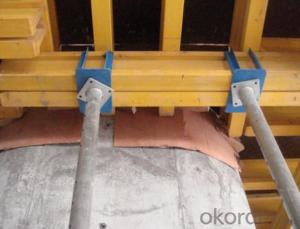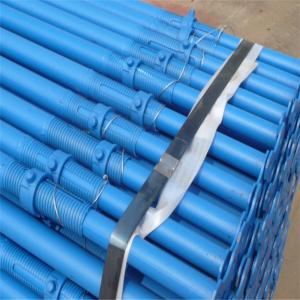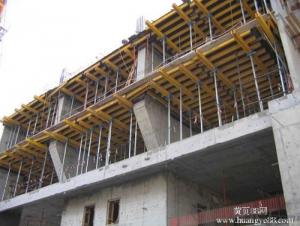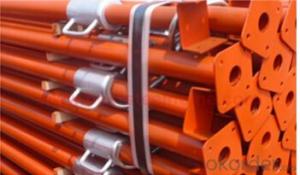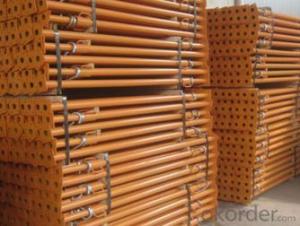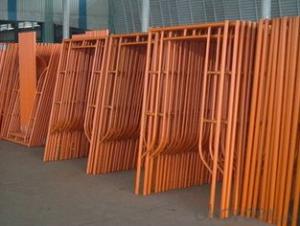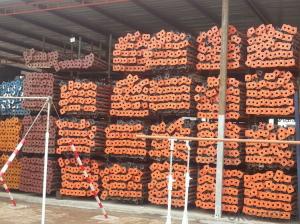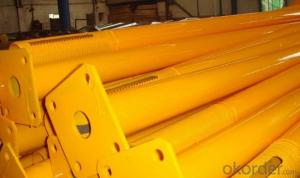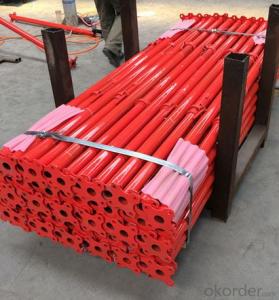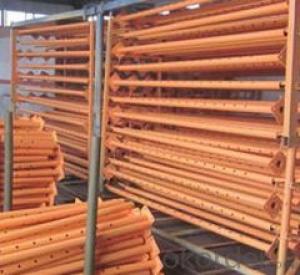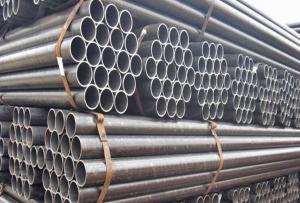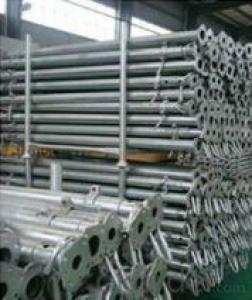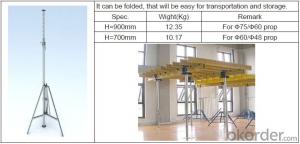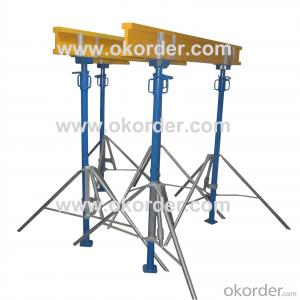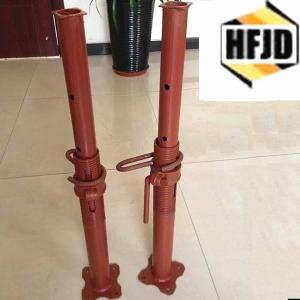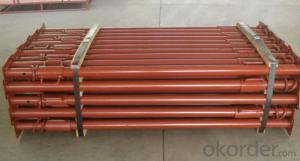ISO 9001 certificate scaffolding steel prop
- Loading Port:
- Tianjin
- Payment Terms:
- TT OR LC
- Min Order Qty:
- 10000 pc
- Supply Capability:
- 10000 pc/month
OKorder Service Pledge
Quality Product, Order Online Tracking, Timely Delivery
OKorder Financial Service
Credit Rating, Credit Services, Credit Purchasing
You Might Also Like
Quick Details
| Model Number: | light duty | ||||
| size: | can be customized as reqested | color: | as requested | certificate: | ISO 9001 passed |
| surface: | painted, galvanized, powder coated | MOQ: | 1*20GP container | plate: | can be square or flover type |
| payment: | TT/LC | delivery: | 15-25 days after confirmation | quantity: | 1000-2000 pieces per day |
| loading quantity: | 1500 pieces in bundle |
Packaging & Delivery
| Packaging Detail: | in bundle or in pallet, or loading in bulk, |
| Delivery Detail: | about 20 days after confirmation |
Specifications
steel prop height: 2.0-3.5M with U head
outer tube:56*1.8mm
inner tube: 48*1.8mm
plates:120*120*4.5 mm
weight:10.4 KG
Steel Prop With Nut
| thickness | 1.8~3.2m | 2.0~3.5m | 2.2~3.9m | ||
1.7mm | flower plate | wire pin | 8.72 kg | 9.35 kg | 10.23 kg |
| G-pin | 8.95 kg | 9.58 kg | 10.46 kg | ||
| square plate | wire pin | 8.93 kg | 9.56 kg | 10.44 kg | |
| G-pin | 9.16 kg | 9.79 kg | 10.67 kg | ||
| 1.8mm | flower plate | wire pin | 9.11 kg | 9.78 kg | 10.71 kg |
| G-pin | 9.34 kg | 10.01 kg | 10.94 kg | ||
square plate | wire pin | 9.32 kg | 9.99 kg | 10.92 kg | |
| G-pin | 9.55 kg | 10.22 kg | 11.15 kg | ||
| 2.0mm | flower plate | wire pin | 9.89 kg | 10.63 kg | 11.66 kg |
| G-pin | 10.12 kg | 10.86 kg | 11.89 kg | ||
| square plate | wire pin | 10.10 kg | 10.84 kg | 11.87 kg | |
| G-pin | 10.33 kg | 11.07 kg | 12.10 kg |
| thickness | 1.8~3.2m | 2.0~3.5m | 2.2~3.9m | ||
2.2mm | flower plate | wire pin | 10.67 kg | 11.48 kg | 12.60 kg |
| G-pin | 10.90 kg | 11.71 kg | 12.83 kg | ||
| square plate | wire pin | 10.88 kg | 11.69 kg | 12.81 kg | |
| G-pin | 11.11 kg | 11.92 kg | 13.04 kg | ||
| 2.5mm | flower plate | wire pin | 12.07 kg | 12.98 kg | 14.25 kg |
| G-pin | 12.30 kg | 13.21 kg | 14.48 kg | ||
square plate | wire pin | 12.28 kg | 13.19 kg | 14.46 kg | |
| G-pin | 12.51 kg | 13.42 kg | 14.69 kg | ||
| 3.0mm | flower plate | wire pin | 13.95 kg | 15.04 kg | 16.55 kg |
| G-pin | 14.18 kg | 15.27 kg | 16.78 kg | ||
| square plate | wire pin | 14.16 kg | 15.25 kg | 16.76 kg | |
| G-pin | 14.39 kg | 15.48 kg | 16.99 kg |
Steel Prop With Cup Nut
| thickness | head plate | base plate | 1.8~3.2m | 2.0~3.5m | 2.2~3.9m |
1.6mm | flower plate | flower plate | 8.55 kg | 9.13 kg | 9.92 kg |
| square plate | square plate | 8.76 kg | 9.34 kg | 10.13 kg | |
| U-head | flower plate | 9.11 kg | 9.69 kg | 10.49 kg | |
| square plate | 9.22 kg | 9.80 kg | 10.59 kg | ||
1.7mm | flower plate | flower plate | 8.93 kg | 9.55 kg | 10.39 kg |
| square plate | square plate | 9.14 kg | 9.76 kg | 10.60 kg | |
| U-head | flower plate | 9.50 kg | 10.11 kg | 10.96 kg | |
| square plate | 9.04 kg | 9.69 kg | 10.58 kg | ||
1.8mm | flower plate | flower plate | 9.31 kg | 9.96 kg | 10.85 kg |
| square plate | square plate | 9.52 kg | 10.17 kg | 11.06 kg | |
| U-head | flower plate | 9.88 kg | 10.53 kg | 11.42 kg | |
| square plate | 9.98 kg | 10.63 kg | 11.53 kg | ||
2.0mm | flower plate | flower plate | 10.07 kg | 10.79 kg | 11.78 kg |
| square plate | square plate | 10.28 kg | 11.00 kg | 11.99 kg | |
| U-head | flower plate | 10.64 kg | 11.36 kg | 12.35 kg | |
| square plate | 10.74 kg | 11.46 kg | 12.45 kg |
- Q: Can steel props be used in shopping mall construction?
- Yes, steel props can be used in shopping mall construction. Steel props, also known as adjustable steel props or steel shoring props, are commonly used in the construction industry to provide temporary support to structures. They are typically used during the construction of multi-story buildings, including shopping malls, where additional support is required for heavy loads and during various stages of construction. Steel props are adjustable in height, making them versatile and suitable for different construction needs. They are designed to provide stability and safety to the structure and can be easily installed, maintained, and removed as needed. Overall, steel props are a reliable and commonly used solution in shopping mall construction.
- Q: Are steel props adjustable in small increments for precise leveling?
- Yes, steel props are adjustable in small increments for precise leveling. Steel props, also known as adjustable steel props or scaffolding props, are commonly used in construction projects to provide temporary support and stability to beams, walls, and ceilings. These props consist of two main components - an outer tube and an inner tube. The inner tube can be adjusted to various heights, allowing for precise leveling of the supported structure. The adjustment is typically done by rotating a threaded collar on the outer tube, which causes the inner tube to move up or down in small increments. This adjustability feature makes steel props an excellent choice for achieving precise and accurate leveling in construction projects.
- Q: What are the differences and similarities between the support of wood, steel, and steel?
- Generally, the steel support is inclined connection member, the most common is the herringbone shape and cross shape, the cross section can be steel pipe, H steel, angle steel, the role is to enhance the stability of the structure. When it comes to brace generally refers to Rachel steel purlin, is thick bar, but also to enhance the stability of the purlin purlin, not easy to lose in the external force under certain failure. Section purlin are generally H steel, C shape, Z shape, is reducing cabin panel span and fixed roof panel. Steel support is a kind of steel structure, which is used as a supporting component, which is used to support the structure of large load.
- Q: What is the typical weight of a steel prop?
- The size and specifications of a steel prop can cause variation in its typical weight. Nevertheless, a construction-standard steel prop generally weighs approximately 20 to 30 kilograms (44 to 66 pounds). It should be emphasized that the weight may deviate depending on the load-bearing capacity needed for a particular application.
- Q: What are the load testing procedures for steel props?
- Load testing procedures for steel props typically involve the following steps: 1. Inspection: Before conducting any load testing, it is important to visually inspect the steel props to ensure they are in good condition. Check for any signs of damage, such as cracks, bends, or rust. If any defects are found, the props should be repaired or replaced before proceeding with the load testing. 2. Selection of test load: Determine the maximum load that the steel props are designed to support. This information can typically be found in the manufacturer's specifications or guidelines. Select a test load that is within this range, usually around 75-80% of the maximum load capacity, to ensure the props are not overstressed during the test. 3. Set up the testing equipment: Prepare the testing area by clearing any obstacles and ensuring a stable and level surface. Place the steel props in the desired position and secure them firmly to prevent any movement during the test. 4. Apply the test load: Gradually apply the predetermined test load to the steel props. This can be achieved by using hydraulic jacks, weights, or other suitable equipment. Monitor the props closely during this process, checking for any signs of deformation or failure. 5. Maintain the load: Once the test load is applied, it should be held for a specific duration, typically around 24 hours, to evaluate the props' long-term stability and durability. Continuously monitor the props during this time to ensure they can adequately support the load without any signs of failure. 6. Record and analyze the results: Throughout the load testing process, document any observations, measurements, and data collected. After the test is complete, analyze the results to determine if the steel props meet the required load-bearing capacity. Assess any structural deformations or failures that may have occurred during the test and evaluate the props' overall performance. 7. Maintenance and retesting: If the steel props pass the load test, they can be deemed safe and suitable for use. However, it is essential to regularly inspect and maintain the props to ensure their continued reliability. Periodic load testing should be conducted at recommended intervals to verify their ongoing strength and performance. It is important to note that load testing procedures may vary depending on specific regulations, standards, or industry requirements. Therefore, it is advisable to consult relevant guidelines and seek professional advice when conducting load testing for steel props.
- Q: What are the typical load testing procedures for steel props?
- The typical load testing procedures for steel props involve subjecting the props to gradually increasing loads until the desired maximum load is achieved. The props are usually tested in a controlled environment, such as a laboratory or testing facility, to ensure accurate and reliable results. The testing process may include measuring deflection, strain, and load capacity to assess the performance and structural integrity of the props. Additionally, non-destructive testing methods like ultrasonic or magnetic particle testing may be employed to detect any potential defects or weaknesses in the props. Ultimately, the goal of load testing procedures for steel props is to validate their ability to withstand the intended load and ensure their safe and effective use in various construction and support applications.
- Q: Steel support is now about how much the price
- Steel support prices will follow the market price of steel, and now probably about 3800 yuan / ton, of course, one day a price.
- Q: Can steel props be used to support roof structures?
- Yes, steel props can be used to support roof structures. Steel props, also known as adjustable steel props or scaffolding props, are commonly used in construction and renovation projects to support various structures, including roof structures. These props are adjustable in height, allowing them to be set at the desired level to provide support to the roof during construction or repair work. Steel props are typically made from high-quality steel, making them strong and capable of withstanding heavy loads. They are also easy to install and dismantle, making them a convenient and reliable choice for providing temporary support to roof structures. Overall, steel props are a popular and effective solution for supporting roof structures in construction projects.
- Q: Can steel props be used for temporary support in bridges?
- Steel props are capable of providing temporary support in bridges. During different stages of construction, including bridge construction, steel props are commonly utilized in construction projects to provide temporary support and stability to structures. These props are adjustable and can be effortlessly installed and removed, making them an optimal option for temporary support in bridges. By distributing the load and providing stability, steel props aid in the bridge structure's ability to sustain its own weight until it is fully completed. It is crucial, however, to guarantee that qualified professionals properly design and install the steel props to ensure the bridge's safety and stability during construction.
- Q: Can steel props be used for temporary support in underground parking structures?
- Steel props are an option for temporary support in underground parking structures. Their frequent use in construction projects is due to their strength, durability, and adjustability. These qualities make them well-suited for supporting the weight and load of the structure during construction or renovation. Additionally, steel props can be easily installed and adjusted to the necessary height, providing stability and security until permanent supports are established. Nevertheless, it is crucial to consult a structural engineer to guarantee proper design and installation that align with the specific requirements and safety standards of the underground parking structure.
Send your message to us
ISO 9001 certificate scaffolding steel prop
- Loading Port:
- Tianjin
- Payment Terms:
- TT OR LC
- Min Order Qty:
- 10000 pc
- Supply Capability:
- 10000 pc/month
OKorder Service Pledge
Quality Product, Order Online Tracking, Timely Delivery
OKorder Financial Service
Credit Rating, Credit Services, Credit Purchasing
Similar products
Hot products
Hot Searches
Related keywords
